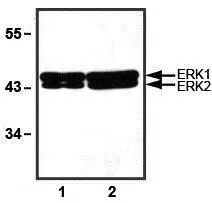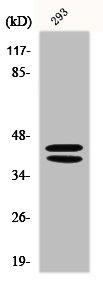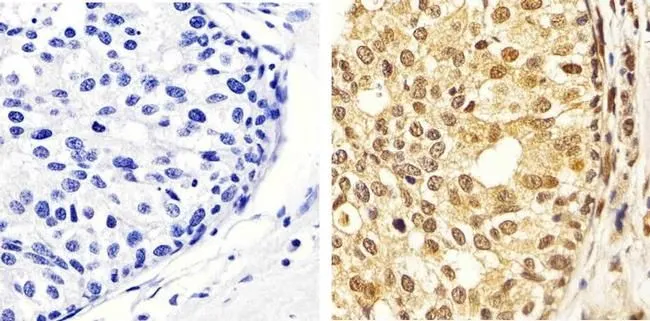
1:1000 (1microg/mL) Ab dilution used in WB of 10microg (1) and 30microg (2) HeLa cell lysates
ERK1/2 antibody [E31R]
GTX82556
ApplicationsWestern Blot
Product group Antibodies
TargetMAPK1
Overview
- SupplierGeneTex
- Product NameERK1/2 antibody [E31R]
- Delivery Days Customer9
- Application Supplier NoteRecommended Starting Dilutions:WB (with ECL): Use at a dilution of 1:1000For best results with other assays (e.g.: Dot, ELISA, IP, etc), please determine optimal working dilution by titration test
- ApplicationsWestern Blot
- CertificationResearch Use Only
- ClonalityMonoclonal
- Clone IDE31R
- Concentration1 mg/ml
- ConjugateUnconjugated
- Gene ID5594
- Target nameMAPK1
- Target descriptionmitogen-activated protein kinase 1
- Target synonymsERK, ERK-2, ERK2, ERT1, MAPK2, NS13, P42MAPK, PRKM1, PRKM2, p38, p40, p41, p41mapk, p42-MAPK, mitogen-activated protein kinase 1, MAP kinase 1, MAP kinase 2, MAPK 2, extracellular signal-regulated kinase 2, mitogen-activated protein kinase 2, protein tyrosine kinase ERK2
- HostMouse
- IsotypeIgG1
- Scientific DescriptionThe protein encoded by this gene is a member of the MAP kinase family. MAP kinases, also known as extracellular signal-regulated kinases (ERKs), act in a signaling cascade that regulates various cellular processes such as proliferation, differentiation, and cell cycle progression in response to a variety of extracellular signals. This kinase is activated by upstream kinases, resulting in its translocation to the nucleus where it phosphorylates nuclear targets. Alternatively spliced transcript variants encoding different protein isoforms have been described. [provided by RefSeq]
- Storage Instruction-20°C or -80°C,2°C to 8°C
- UNSPSC12352203
References
- Ginkgolide B promotes neuronal differentiation through the Wnt/beta-catenin pathway in neural stem cells of the postnatal mammalian subventricular zone. Li MY et al., 2018 Oct 8, Sci RepRead more
- Estrogen adversely affects the prognosis of patients with lung adenocarcinoma. Hsu LH et al., 2015 Jan, Cancer SciRead more



![WB analysis of wild-type (WT) and ERK2 knockout (KO) HeLa cell extracts using GTX00945 ERK2 antibody [GT1183]. Dilution : 1:1000 Laoding : 25microg](https://www.genetex.com/upload/website/prouct_img/normal/GTX00945/GTX00945_20200327_WB_1_w_23053121_922.webp)
![ICC/IF analysis of Eca-109 cells using GTX83148 ERK2 antibody [4C11]. Green : ERK2 Red : Actin filament](https://www.genetex.com/upload/website/prouct_img/normal/GTX83148/GTX83148_20170912_ICCIF_w_23061322_599.webp)
![IHC-P analysis of human pancreas tissue using GTX84151 ERK2 antibody [4C2]. Antigen retrieval : Heat-induced epitope retrieval by 10mM citrate buffer, pH6.0, 100oC for 10min.](https://www.genetex.com/upload/website/prouct_img/normal/GTX84151/GTX84151_2379_IHC-P_w_23061420_981.webp)
![IP analysis of DDDDK tagged ERK2 overexpressed HEK293T lysate using GTX84153 ERK2 antibody [4D10].After extensive wash to remove any non-specific binding, the immuno-precipitated products were analyzed with rabbit anti-DDDDK polyclonal antibody. IP reaction : 2microg antibody / 500microl cell lysate](https://www.genetex.com/upload/website/prouct_img/normal/GTX84153/GTX84153_3348_IP_w_23061420_970.webp)
![IHC-P analysis of human breast adenocarcinoma tissue using GTX84154 ERK2 antibody [6F8]. Antigen retrieval : Heat-induced epitope retrieval by 10mM citrate buffer, pH6.0, 100oC for 10min.](https://www.genetex.com/upload/website/prouct_img/normal/GTX84154/GTX84154_2380_IHC-P_w_23061420_118.webp)